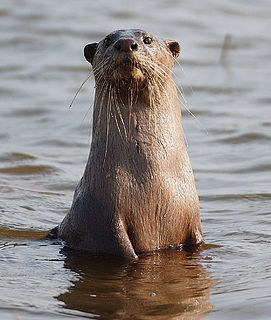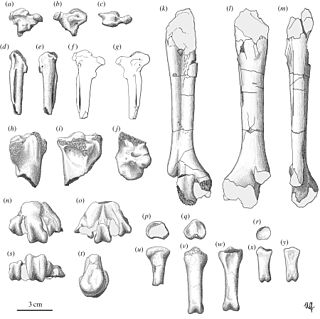
The Mustelidae are a family of carnivorous mammals, including weasels, badgers, otters, ferrets, martens, minks and wolverines, among others. Mustelids are a diverse group and form the largest family in the order Carnivora, suborder Caniformia. They comprise about 66–70 species across nine subfamilies.

Otters are carnivorous mammals in the subfamily Lutrinae. The 13 extant otter species are all semiaquatic, aquatic, or marine, with diets based on fish and invertebrates. Lutrinae is a branch of the Mustelidae family, which also includes weasels, badgers, mink, and wolverines, among other animals.

Megaloceros is an extinct genus of deer whose members lived throughout Eurasia from the early Pleistocene to the beginning of the Holocene and were important herbivores during the Ice Ages. The largest species, Megaloceros giganteus, vernacularly known as the "Irish elk" or "giant elk", is also the best known. Fallow deer are thought to be their closest living relatives. Megaloceros is part of the deer family which includes moose, elk, reindeer, and other cervids.

Lutra is a genus of otters, one of seven in the subfamily Lutrinae.

Gargano is a historical and geographical sub-region in the province of Foggia, Apulia, southeast Italy, consisting of a wide isolated mountain massif made of highland and several peaks and forming the backbone of the Gargano Promontory projecting into the Adriatic Sea, the "spur" on the Italian "boot". The high point is Monte Calvo at 1,065 m (3,494 ft). Most of the upland area, about 1,200 km2 (460 sq mi), is part of the Gargano National Park, founded in 1991. In this region since 1978 a feud has been fought between the clans of the Società foggiana.
Mammuthus lamarmorai is a species of mammoth which lived during the late Middle and Upper Pleistocene on the island of Sardinia. M. lamarmorai is a dwarf species, as it is estimated to have reached a shoulder height of only 1.4 m and weighed about 550 kg. This pygmy mammoth has been found mostly in the fine-grained sediments of the western part of the island.

Lutrogale was proposed as generic name by John Edward Gray in 1865 for otters with a convex forehead and nose, using the smooth-coated otter L. perspicillata as type species.

Prolagus is an extinct genus of pika within the order Lagomorpha. Over 20 species of Prolagus have been named, beginning in the Early Miocene in Europe 20 million years ago, where it ranged widely for most of the epoch; by the end of the Middle Pleistocene, it was confined to a single species, the Sardinian pika, on the Mediterranean islands of Corsica, Sardinia, and surrounding islands, where it survived into historical times. In Africa and Asia, the genus is known from the Miocene and Pliocene. The scientific name may mean "before hares" or "primitive hares".

Megalenhydris barbaricina is a Late Pleistocene giant otter from Sardinia. It is known from a single skeleton, discovered in the Grotta di Ispinigoli near Dorgali, and was described in 1987. The species is one of four extinct otter species from Sardinia and Corsica. The others are Algarolutra majori, Lutra castiglionis and Sardolutra ichnusae. This otter was large, possibly even larger than the extant Pteronura, which can reach two meters in length. The structure of the teeth points to a diet of shellfish and/or crustaceans. A special characteristic of the species is the flattening of the first few caudal vertebrae. This might point to a slightly flattened tail.

Sardolutra ichnusae is an extinct species of otter from the Late Pleistocene of Sardinia. It was originally described as Nesolutra ichnusae. It was a rather small species of otter, probably living in the sea. Among its characteristics is a relatively very large baculum, larger than in any living otter. The species probably evolved from a species of Lutra, maybe L. castiglionis.
Algarolutra is an extinct endemic genus of otter from the Pleistocene of Corsica and Sardinia. The single species A. majori was originally attributed to the genus Cyrnaonyx and its type species C. antiqua, which was based on fossils from Corsica and also from mainland France. From mainland Europe, only lower dentition was known, whereas from Corsica and Sardinia only upper dentition was known. When a Cyrnaonyx antiqua fossil with both upper and lower dentition was found in England, it became clear that the species majori was too different to keep even in the same genus and the genus Algarolutra was described. appearing to belong to separate genera. A. majori is known only from very sparse evidence.

Enhydriodon, known as the bear otter, is an extinct genus of typically large otters that lived in what is now Kenya, Ethiopia, Uganda, Chad, South Africa, and India from the late Miocene up to early Pleistocene. The otter is thought to be a relative of modern-day sea otters. E. omoensis and E. dikikae are described as the largest mustelids to have ever existed, though only fragments of the genus have been found such as the skull, femur, and dental remains in Ethiopia. Multiple estimates put them at about 200 kilograms (440 lb) while E. omoensis was described to be lion-sized, making them the largest mustelids described so far. Most species of the Enhydriodon genus are presumed to be semi-aquatic given most of the fossil isotope values being similar to fossilized semi-aquatic animals like hippopotamuses. The largest species, Enhydriodon omoensis, however, was determined to be a terrestrial predator, capable of hunting herbivorous terrestrial prey. Enhydriodon is part of the bunodont otters group, referring to otter genera with non-bladelike carnassials including the extant Enhydra genus and its extinct relatives that lived from the late Miocene to the early Pleistocene.

Garganornis is an extinct genus of enormous flightless anatid waterfowl from the Late Miocene of Gargano, Italy. The genus contains one species, G. ballmanni, named by Meijer in 2014. Its enormous size is thought to have been an adaptation to living in exposed, open areas with no terrestrial predators, and as a deterrent to the indigenous aerial predators like the eagle Garganoaetus and the giant barn owl Tyto gigantea.
Lontra weiri is a fossil species in the carnivoran family Mustelidae from the Hagerman Fossil Beds of Idaho. It shared its habitat with Satherium piscinarium, a probable ancestor of the giant otter of South America. It is named in honor of musician Bob Weir, and is the oldest known member of its genus. Prior to its discovery, Lontra was thought to have evolved from Lutra licenti, which dates from the Pleistocene of East Asia.
Hoplocetus is an extinct genus of raptorial cetacean of the sperm whale superfamily, Physeteroidea. Its remains have been found in the Miocene of Belgium, France, Germany and Malta, the Pliocene of Belgium and France, and the Pleistocene of the United Kingdom and South Carolina.
The Cretan otter(Lutrogale cretensis) is an extinct otter that was endemic to Crete during the Pleistocene.

Enhydrictis is a genus of extinct mustelid, belonging to the subfamily Galictinae. The type species, and best known, is Enhydrictis galictoides from the Pleistocene of Sardinia and Corsica.
Lutra castiglionis, the Castiglione otter or Corsican otter, is an extinct species of otter that was endemic to Corsica during the Pleistocene.
Proadinotherium is an extinct genus of toxodontid. It lived between the Late Oligocene and the Early Miocene in what is now South America.











